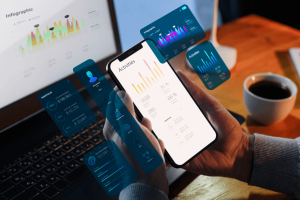The Future of Food Delivery: Innovations and Trends in 2023

The food delivery sector has grown significantly during the past several years due to consumer convenience & demand. The global market cap of food delivery is around 130 billion USD, which is expected to grow exponentially in upcoming years. Consumers who never had a habit of ordering online food have also started ordering online without moving out of their comfort zone.
As we move ahead, there are a lot of future trends and innovations lined up with the industry which can shape the online food delivery industry. So, it is important to know what are the latest trends in the industry because these trends can affect food delivery app development costs.
Here are the food delivery app development trends for 2023 and beyond:
1: Delivery direct from restaurants
The first and foremost trend gaining popularity is that restaurants have started delivering food directly to consumers rather than relying on third-party delivery services. By doing so, they can maximize their budget as they don’t have to pay the charges to delivery apps. In contrast, they also have the added advantage of understanding consumer behavior and preferences. However, not all restaurants can afford this privilege as it can increase the vehicle cost and add stress to their shoulders.
2: The future of the third-party delivery services
As mentioned above, some restaurants prefer to add their own fleet to provide delivery services to their consumers. Outsourcing delivery services is still one of the industry’s top trends, as most restaurants cannot afford a personal delivery fleet. This benefits the business, including freedom from employment connections, a lack of vehicle-related expenses, and the ability to rely on a broader pool of couriers.
3: Grocery delivery
Online grocery shopping from the top supermarkets and local grocery stores has become the top choice for consumers to buy daily grocery supplies. Like the restaurant sector, most large grocery giants usually had to rely on third-party delivery services for groceries. Now, some top supermarkets have their own doorstep delivery service, which helps them differentiate from their potential competitors. They don’t have to rely on third-party apps for integrity.
4: Food delivery app development trends:
The business of developing food delivery apps is evolving quickly, and a number of developments will have an influence on future food delivery app development costs. Food delivery applications incorporate AI and machine learning algorithms to enhance the user experience through personalized suggestions, improved delivery routes, and demand forecasting. The ordering procedure is being made more accessible and convenient by using voice assistants like Google Assistant and Amazon’s Alexa. In order to increase security, decrease downtime, and improve scalability, cloud technology is being used. Finally, a route optimization API is being used to minimize delivery times and save money on fuel costs.
All of these breakthroughs and trends will necessitate hefty investments in infrastructure and technology. Thus, the price of developing food delivery apps will continue to be a major consideration for businesses trying to enter the industry. However, because of the industry’s potential for expansion and profitability, many businesses are eager to invest in creating food delivery applications.
5: Data analytics & machine learning for personalized recommendations
Data analytics and machine learning, which may give useful insights into consumer behavior, preferences, and ordering history, can assist food delivery services in optimizing their operations. This data may be analyzed to provide tailored suggestions, enhance the precision of delivery estimates, and streamline delivery routes. These technologies can also aid in demand forecasting, allowing for more precise food preparation and waste minimization. Machine learning algorithms can assist delivery drivers in selecting the most effective routes by analyzing data from numerous sources, including weather predictions and traffic reports. Data analytics and machine learning may benefit food delivery businesses by increasing operational effectiveness, lowering costs, and improving customer satisfaction.
6: Sustainable packaging
Sustainable packaging is becoming more crucial as online food delivery grows and consumers become more ecologically aware. Examples of sustainable packaging materials that can lessen the environmental effect of food delivery by reducing the amount of plastic trash that ends up in landfills and seas include biodegradable plastics, paper-based goods, and reusable containers. These are the materials that food delivery services use to lessen their carbon impact and promote recycling or reusing packaging. Additionally, being investigated are cutting-edge packaging options like edible packaging produced from natural components. Meal delivery firms must invest in these materials to fulfill customer expectations and lessen their environmental effect. Sustainable packaging will be a crucial part of online meal delivery in the future. One should not be surprised to see innovations and trends in sustainable packaging as it is an emerging trend as the demand for food delivery increases.
7: Robot & drone delivery
Robotic and drone delivery systems have the potential to revolutionize the food delivery business and pave the way for a more productive and economical future. By using these technologies, food delivery costs may be reduced while delivery times can be increased, thereby improving customer satisfaction. These innovations can also reduce emissions associated with traditional delivery techniques and road congestion. Robot and drone delivery can expedite food delivery, making it quicker, more convenient, and more ecologically friendly, thanks to their capacity to navigate heavily congested regions and bring orders straight to consumers’ doors. It is anticipated that the adoption of these cutting-edge distribution techniques will grow in popularity over the next few years due to continued technological breakthroughs.
Why is it high time to invest in food delivery app development?
The food delivery industry has been growing rapidly in recent years, thanks to the convenience and variety of options it offers to customers through the latest technologies and astounding features. Building a food delivery app can help restaurants and food businesses to create a direct connection with their customers, increase their brand awareness and loyalty, and optimize their operations and revenue.
Conclusion
Due to changes in customer tastes and technological improvements, the food delivery sector is rapidly growing. For a better customer experience, lower costs, and lessening of the environmental effect, robotic and drone deliveries, data analytics, and sustainable packaging are being welcomed. Trends like plant-based cuisine, ghost kitchens, and virtual helpers demonstrate how the market is always changing to match consumers’ wants. To remain competitive and satisfy client requirements, businesses must keep up with these developments and advances in the food delivery sector.






